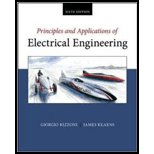
List five applications of electric motors in thecommon household.
To discuss:
Five applications of electric motors in the common household.
Explanation of Solution
An electric motor is a machine that converts electrical energy into mechanical energy. The electric motor has a rotating part, which rotates due to the interaction between the magnetic field and the electric current in the motor. Depending on the type of power source are mainly two types of electric motors, AC motors and DC motors.
The type of electric motors used depends upon the application for which they have been employed. The type of motor can be single-phase ac motor, three-phase ac motor, or a dc motor. The electric motors have a wide range of applications like industrial, commercial, and household applications.
The first household application of an electric motor is an electric fan. The electric motor employed in fan is single phase ac motor and consumes very less power, therefore, also called fractional kilowatt motor.
The second household application of electric motor is in the washing machine, which generally employs a universal motor that can operate both AC and DC power.
The third household application of the electric motor is in the air conditioner, which employs ac motor that operates at
The fourth household application of the electric motor is in hairdryers, which employ a permanent magnet DC motor, which runs at a very high speed of
The fifth household application of the electric motor is in the refrigerator in which they are used to compress the coolant, as the most common type of motor used in HVAC applications is AC motor only.
Therefore, the five main applications of the electric motors in the household are electric fans, washing machines, air conditioners, hairdryers, and refrigerators.
Want to see more full solutions like this?
Chapter 1 Solutions
Principles and Applications of Electrical Engineering
- What are the four conditions that must be met before a generator is connected to a 3 phase system?arrow_forwardPlease solve this question step by step and handwritten and do not use chat gpt or ai tools thank you very much!arrow_forwardPlease solve question c and d step by step and handwritten and do not use chat gpt or ai tools thank you very much!arrow_forward
- Please solve questions d,e,f step by step and handwritten and do not use chat gpt or ai tools thank you very much!arrow_forwardPlease solve this question step by step and handwritten and do not use chat gpt or ai tools thank you very much!arrow_forwardPlease solve question c,d,e step by step and handwritten and do not use chat gpt or ai tools thank you very much!arrow_forward
- Q1: Design a logic circuit for the finite-state machine described by the assigned table in Fig. 1: Using D flip-flops. a. b. Using T flip-flops. Present Next State Output State x=0 x=0 YE Y₁Y Y₁Y Z 00 00 01 0 0 от 00 0 0 10 00 10 11 00 10 0arrow_forwardFind Va and Vb using mesh analysisarrow_forwardFind Va and Vb using Mesh analysisarrow_forward
- Find Va and Vb using nodal analysisarrow_forward2. Using the approximate method, hand sketch the Bode plot for the following transfer functions. a) H(s) = 10 b) H(s) (s+1) c) H(s): = 1 = +1 100 1000 (s+1) 10(s+1) d) H(s) = (s+100) (180+1)arrow_forwardQ4: Write VHDL code to implement the finite-state machine described by the state Diagram in Fig. 1. Fig. 1arrow_forward
 Delmar's Standard Textbook Of ElectricityElectrical EngineeringISBN:9781337900348Author:Stephen L. HermanPublisher:Cengage Learning
Delmar's Standard Textbook Of ElectricityElectrical EngineeringISBN:9781337900348Author:Stephen L. HermanPublisher:Cengage Learning
